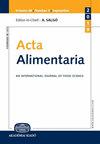骆驼初乳和乳蛋白的酶解物对一种与肥胖相关的关键酶显示出抑制活性
IF 1
4区 农林科学
Q4 FOOD SCIENCE & TECHNOLOGY
引用次数: 0
摘要
本研究旨在研究骆驼初乳和乳蛋白及其酶解产物的抗肥胖潜力。用六种蛋白水解酶(胃蛋白酶、胰蛋白酶、α-糜蛋白酶、胰酶、木瓜蛋白酶和蛋白酶)处理骆驼初乳和乳蛋白。测量水解程度以验证蛋白质的降解。使用胰脂肪酶抑制试验评价体外抗肥胖活性。骆驼初乳和乳蛋白水解物的水解度不同,从17.69到43.97%不等。骆驼初乳和奶蛋白水解物中的蛋白质含量分别在56.08到61.95%和37.39到41.72%之间。在所有测试浓度下,水解产物均显示出显著高于未消化蛋白质的抗肥胖活性(P<0.05)。胰蛋白酶产生的牛初乳蛋白水解产物具有最高的抗肥胖潜力(59.92%)。这些结果表明,初乳和乳蛋白水解物可用于配制功能性食品和营养品。本文章由计算机程序翻译,如有差异,请以英文原文为准。
Enzymatic hydrolysates from camel colostrum and milk proteins display inhibitory activity toward a key enzyme related to obesity
This study aimed to investigate the anti-obesity potential of camel colostrum and milk proteins as well as their enzymatic hydrolysates. Camel colostrum and milk proteins were treated using six proteolytic enzymes (pepsin, trypsin, α-chymotrypsin, pancreatin, papain, and pronase). The degree of hydrolysis was measured to verify the degradation of proteins. The in vitro anti-obesity activity was evaluated using the pancreatic lipase inhibitory assay. Camel colostrum and milk protein hydrolysates exhibited different degrees of hydrolysis ranging from 17.69 to 43.97%. The protein content varied between 56.08–61.95% and 37.39–41.72% for camel colostrum and milk protein hydrolysates, respectively. The hydrolysates displayed significantly higher anti-obesity activity than the undigested proteins at all tested concentrations (P < 0.05). Colostrum protein hydrolysate generated with pancreatin had the highest anti-obesity potential (59.92%). These results suggest that colostrum and milk protein hydrolysates could be used to formulate functional foods and nutraceuticals.
求助全文
通过发布文献求助,成功后即可免费获取论文全文。
去求助
来源期刊

Acta Alimentaria
农林科学-食品科技
CiteScore
1.80
自引率
0.00%
发文量
47
审稿时长
18-36 weeks
期刊介绍:
Acta Alimentaria publishes original papers and reviews on food science (physics, physical chemistry, chemistry, analysis, biology, microbiology, enzymology, engineering, instrumentation, automation and economics of foods, food production and food technology, food quality, post-harvest treatments, food safety and nutrition).
 求助内容:
求助内容: 应助结果提醒方式:
应助结果提醒方式:


